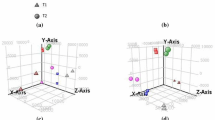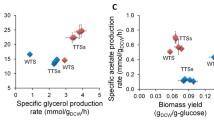Abstract
Adaptation to temperature fluctuation is essential for the survival of all living organisms. Although extensive research has been done on heat and cold shock responses, there have been no reports on global responses to cold shock below 10°C or near-freezing. We examined the genome-wide expression in Saccharomyces cerevisiae, following exposure to 4°C. Hierarchical cluster analysis showed that the gene expression profile following 4°C exposure from 6 to 48 h was different from that at continuous 4°C culture. Under 4°C exposure, the genes involved in trehalose and glycogen synthesis were induced, suggesting that biosynthesis and accumulation of those reserve carbohydrates might be necessary for cold tolerance and energy preservation. The observed increased expression of phospholipids, mannoproteins, and cold shock proteins (e.g., TIP1) is consistent with membrane maintenance and increased permeability of the cell wall at 4°C. The induction of heat shock proteins and glutathione at 4°C may be required for revitalization of enzyme activity, and for detoxification of active oxygen species, respectively. The genes with these functions may provide the ability of cold tolerance and adaptation to yeast cells.



Similar content being viewed by others
References
Abramova N, Sertil O, Mehta S, Lowry CV (2001). Reciprocal regulation of anaerobic and aerobic cell wall mannoprotein gene expression in Saccharomyces cerevisiae. J Bacteriol 183:2881–2887
Aguilar PS, Lopez P, de Mendoza D (1999) Transcriptional control of the low-temperature-inducible des gene, encoding the delta5 desaturase of Bacillus subtilis. J Bacteriol 181:7028–7033
Avery AM, Avery SV (2001) Saccharomyces cerevisiae expresses three phospholipid hydroperoxide glutathione peroxidases. J Biol Chem 276:33730–33735
Bell W, Sun W, Hohmann S, Wera S, Reinders A, De Virgilio C, Wiemken A, Thevelein JM (1998) Composition and functional analysis of the Saccharomyces cerevisiae trehalose synthase complex. J Biol Chem 273:33311–33319
Carman GM, Zeimetz GM (1996) Regulation of phospholipid biosynthesis in the yeast Saccharomyces cerevisiae. J Biol Chem 271:13293–13296
Causton HC, Ren B, Koh SS, Harbison CT, Kanin E, Jennings EG, Lee TI, True HL, Lander ES, Young RA (2001) Remodeling of yeast genome expression in response to environmental changes. Mol Biol Cell 12:323–337
Choi JH, Lou W, Vancura A (1998) A novel membrane-bound glutathione S-transferase functions in the stationary phase of the yeast Saccharomyces cerevisiae. J Biol Chem 273:29915–29922
Collinson EJ, Grant CM (2003) Role of yeast glutaredoxins as glutathione S-transferases. J Biol Chem 278:22492–22497 (Epub 2003 April 8)
Delneri D, Gardner DC, Oliver SG (1999) Analysis of the seven-member AAD gene set demonstrates that genetic redundancy in yeast may be more apparent than real. Genetics 153:1591–1600
Fang L, Hou Y, Inouye M (1998) Role of the cold-box region in the 5′ untranslated region of the cspA mRNA in its transient expression at low temperature in Escherichia coli. J Bacteriol 180:90–95
Francois J, Parrou JL (2001) Reserve carbohydrates metabolism in the yeast Saccharomyces cerevisiae. FEMS Microbiol Rev 25:125–145
Fujita K, Matsuyama A, Kobayashi Y, Iwahashi H (2004) Comprehensive gene expression analysis of the response to straight-chain alcohols in Saccharomyces cerevisiae using cDNA microarray. J Appl Microbiol 97:57–67
Gasch AP, Spellman PT, Kao CM, Carmel-Harel O, Eisen MB, Storz G, Botstein D, Brown PO (2000) Genomic expression programs in the response of yeast cells to environmental changes. Mol Biol Cell 11:4241–4257
Godon C, Lagniel G, Lee J, Buhler JM, Kieffer S, Perrot M, Boucherie H, Toledano MB, Labarre J (1998) The H2O2 stimulon in Saccharomyces cerevisiae. J Biol Chem 273:22480–22489
Guy C (1999) Molecular responses of plants to cold shock and cold acclimation. J Mol Microbiol Biotechnol 1:231–242
Homma T, Iwahashi H, Komatsu Y (2003) Yeast gene expression during growth at low temperature. Cryobiology 46:230–237
Inaba M, Suzuki I, Szalontai B, Kanesaki Y, Los DA, Hayashi H, Murata N (2003) Gene-engineered rigidification of membrane lipids enhances the cold inducibility of gene expression in Synechocystis. J Biol Chem 278:12191–12198
Iwahashi H, Nwaka S, Obuchi K, Komatsu Y (1998) Evidence for the interplay between trehalose metabolism and Hsp104 in yeast. Appl Environ Microbiol 64:4614–4617
Iwahashi H, Nwaka S, Obuchi K (2000) Evidence for contribution of neutral trehalase in barotolerance of Saccharomyces cerevisiae. Appl Environ Microbiol 66:5182–5185
Jones PG, Inouye M (1996) RbfA, a 30S ribosomal binding factor, is a cold-shock protein whose absence triggers the cold-shock response. Mol Microbiol 21:1207–1218
Kandror O, Goldberg AL (1997) Trigger factor is induced upon cold shock and enhances viability of Escherichia coli at low temperatures. Proc Natl Acad Sci USA 94:4978–4981
Kandror O, DeLeon A, Goldberg AL (2002) Trehalose synthesis is induced upon exposure of Escherichia coli to cold and is essential for viability at low temperatures. Proc Natl Acad Sci USA 99:9727–9732 (Epub 2002 July 8)
Kandror O, Bretschneider N, Kreydin E, Cavalieri D, Goldberg AL (2004). Yeast adapt to near-freezing temperatures by STRE/Msn2,4-dependent induction of trehalose synthesis and certain molecular chaperones. Mol Cell 13:771–781
Kitagawa E, Takahashi J, Momose Y, Iwahashi H (2002) Effects of the pesticide thiuram: genome-wide screening of indicator genes by yeast DNA microarray. Environ Sci Technol 36:3908–3915
Kondo K, Inouye M (1991) TIP 1, a cold shock-inducible gene of Saccharomyces cerevisiae. J Biol Chem 266:17537–17544
Kondo K, Inouye M (1992) Yeast NSR1 protein that has structural similarity to mammalian nucleolin is involved in pre-rRNA processing. J Biol Chem 267:16252–16258
Kowalski LR, Kondo K, Inouye M (1995) Cold-shock induction of a family of TIP1-related proteins associated with the membrane in Saccharomyces cerevisiae. Mol Microbiol 15:341–353
Lashkari DA, DeRisi JL, McCusker JH, Namath AF, Gentile C, Hwang SY, Brown PO, Davis RW (1997) Yeast microarrays for genome wide parallel genetic and gene expression analysis. Proc Natl Acad Sci USA 94:13057–13062
Lillie SH, Pringle JR (1980) Reserve carbohydrate metabolism in Saccharomyces cerevisiae: responses to nutrient limitation. J Bacteriol 143:1384–1394
Mizukami S, Suzuki Y, Kitagawa E, Iwahashi H (2004) Standardization of cDNA microarray technology for toxicogenomics; essential data for initiating cDNA microarray studies. Chem BioInformatics J 4:38–55
Moskovitz J, Berlett BS, Poston JM, Stadtman ER (1997) The yeast peptide–methionine sulfoxide reductase functions as an antioxidant in vivo. Proc Natl Acad Sci USA 94:9585–9589
Mountain HA, Bystrom AS, Larsen JT, Korch C (1991) Four major transcriptional responses in the methionine/threonine biosynthetic pathway of Saccharomyces cerevisiae. Yeast 7:781–803
Murata Y, Momose Y, Hasegawa M, Iwahasi H, Komatsu Y (2002) Cluster analysis and display of genome-wide expression profiles in dimethyl sulfoxide treatment. Chem BioInformatics J 2:18–31
Murata Y, Watanabe T, Sato M, Momose Y, Nakahara T, Oka S, Iwahashi H (2003) Dimethyl sulfoxide exposure facilitates phospholipid biosynthesis and cellular membrane proliferation in yeast cells. J Biol Chem 278:33185–33193 (Epub 2003 May 27)
Nakagawa Y, Sugioka S, Kaneko Y, Harashima S (2001) O2R, a novel regulatory element mediating Rox1p-independent O(2) and unsaturated fatty acid repression of OLE1 in Saccharomyces cerevisiae. J Bacteriol 183:745–751
Nakagawa Y, Sakumoto N, Kaneko Y, Harashima S (2002) Mga2p is a putative sensor for low temperature and oxygen to induce OLE1 transcription in Saccharomyces cerevisiae. Biochem Biophys Res Commun 291:707–713
Odani M, Komatsu Y, Oka S, Iwahashi H (2003) Screening of genes that respond to cryopreservation stress using yeast DNA microarray. Cryobiology 47:155–164
Parrou JL, Teste MA, Francois J (1997) Effects of various types of stress on the metabolism of reserve carbohydrates in Saccharomyces cerevisiae: genetic evidence for a stress-induced recycling of glycogen and trehalose. Microbiology 143:1891–1900
Pedrajas JR, Kosmidou E, Miranda-Vizuete A, Gustafsson JA, Wright AP, Spyrou G (1999) Identification and functional characterization of a novel mitochondrial thioredoxin system in Saccharomyces cerevisiae. J Biol Chem 274:6366–6373
Phadtare S, Inouye M, Severinov K (2004) The mechanism of nucleic acid melting by a CspA family protein. J Mol Biol 337:147–155
Rachidi N, Martinez MJ, Barre P, Blondin B (2000) Saccharomyces cerevisiae PAU genes are induced by anaerobiosis. Mol Microbiol 35:1421–1430
Sahara T, Goda T, Ohgiya S (2002) Comprehensive expression analysis of time-dependent genetic responses in yeast cells to low temperature. J Biol Chem 277:50015–50021
Singer MA, Lindquist S (1998) Thermotolerance in Saccharomyces cerevisiae: the Yin and Yang of trehalose. Trends Biotechnol 16:460–468
Stolc V, Katz A, Altman S (1998) Rpp2, an essential protein subunit of nuclear RNase P, is required for processing of precursor tRNAs and 35S precursor rRNA in Saccharomyces cerevisiae. Proc Natl Acad Sci USA 95:6716–6721
Suzuki I, Kanesaki Y, Mikami K, Kanehisa M, Murata N (2001) Cold-regulated genes under control of the cold sensor Hik33 in Synechocystis. Mol Microbiol 40:235–244
Thieringer HA, Jones PG, Inouye M (1998) Cold shock and adaptation. Bioessays 20:49–57
Thomas D, Surdin-Kerjan Y (1997) Metabolism of sulfur amino acids in Saccharomyces cerevisiae. Microbiol Mol Biol Rev 61:503–532
Thomas D, Becker A, Surdin-Kerjan Y (2000) Reverse methionine biosynthesis from S-adenosylmethionine in eukaryotic cells. J Biol Chem 275:40718–40724
Varela JC, Praekelt UM, Meacock PA, Planta RJ, Mager WH (1995) The Saccharomyces cerevisiae HSP12 gene is activated by the high-osmolarity glycerol pathway and negatively regulated by protein kinase A. Mol Cell Biol 15:6232–6245
Zarka DG, Vogel JT, Cook D, Thomashow MF (2003) Cold induction of Arabidopsis CBF genes involves multiple ICE (inducer of CBF expression) promoter elements and a cold-regulatory circuit that is desensitized by low temperature. Plant Physiol 133:910–918 (Epub 2003 September 18)
Zlotnik H, Fernandez MP, Bowers B, Cabib E (1984) Saccharomyces cerevisiae mannoproteins form an external cell wall layer that determines wall porosity. J Bacteriol 159:1018–1026
Acknowledgement
We are grateful to Dr. R. Rakwal for proofreading this manuscript.
Author information
Authors and Affiliations
Corresponding author
Additional information
Communicated by K. Horikoshi
Rights and permissions
About this article
Cite this article
Murata, Y., Homma, T., Kitagawa, E. et al. Genome-wide expression analysis of yeast response during exposure to 4°C. Extremophiles 10, 117–128 (2006). https://doi.org/10.1007/s00792-005-0480-1
Received:
Accepted:
Published:
Issue Date:
DOI: https://doi.org/10.1007/s00792-005-0480-1




